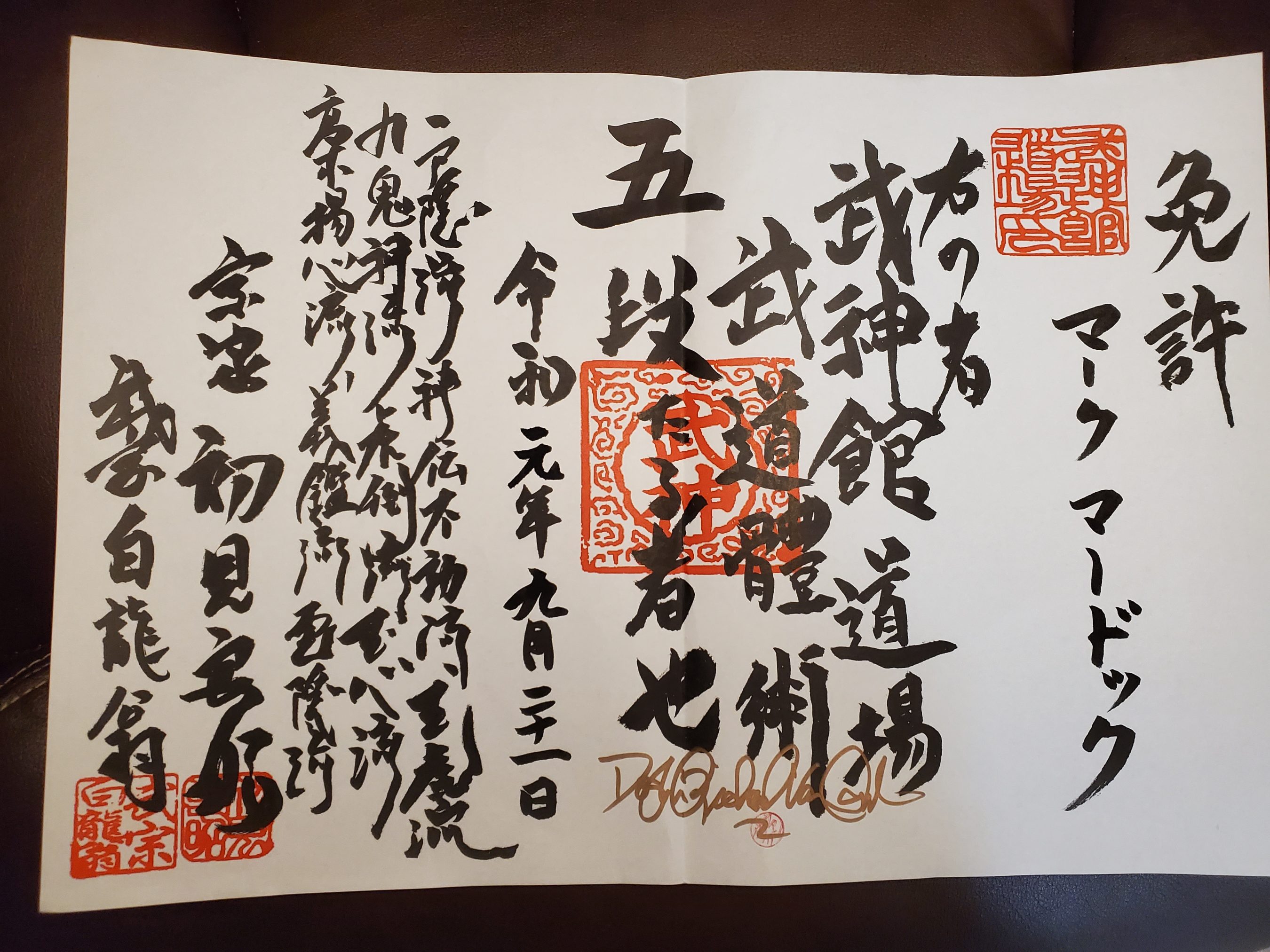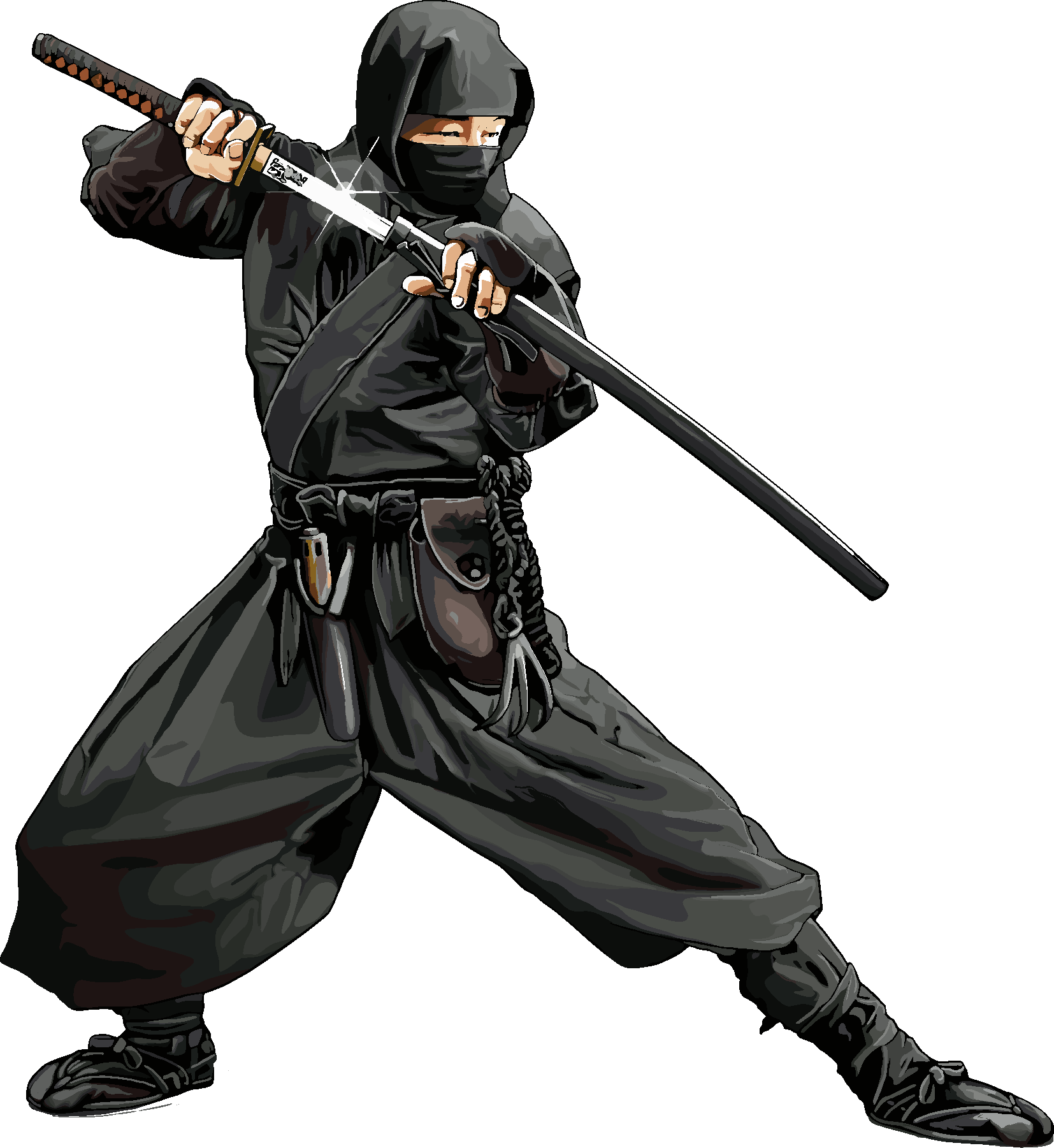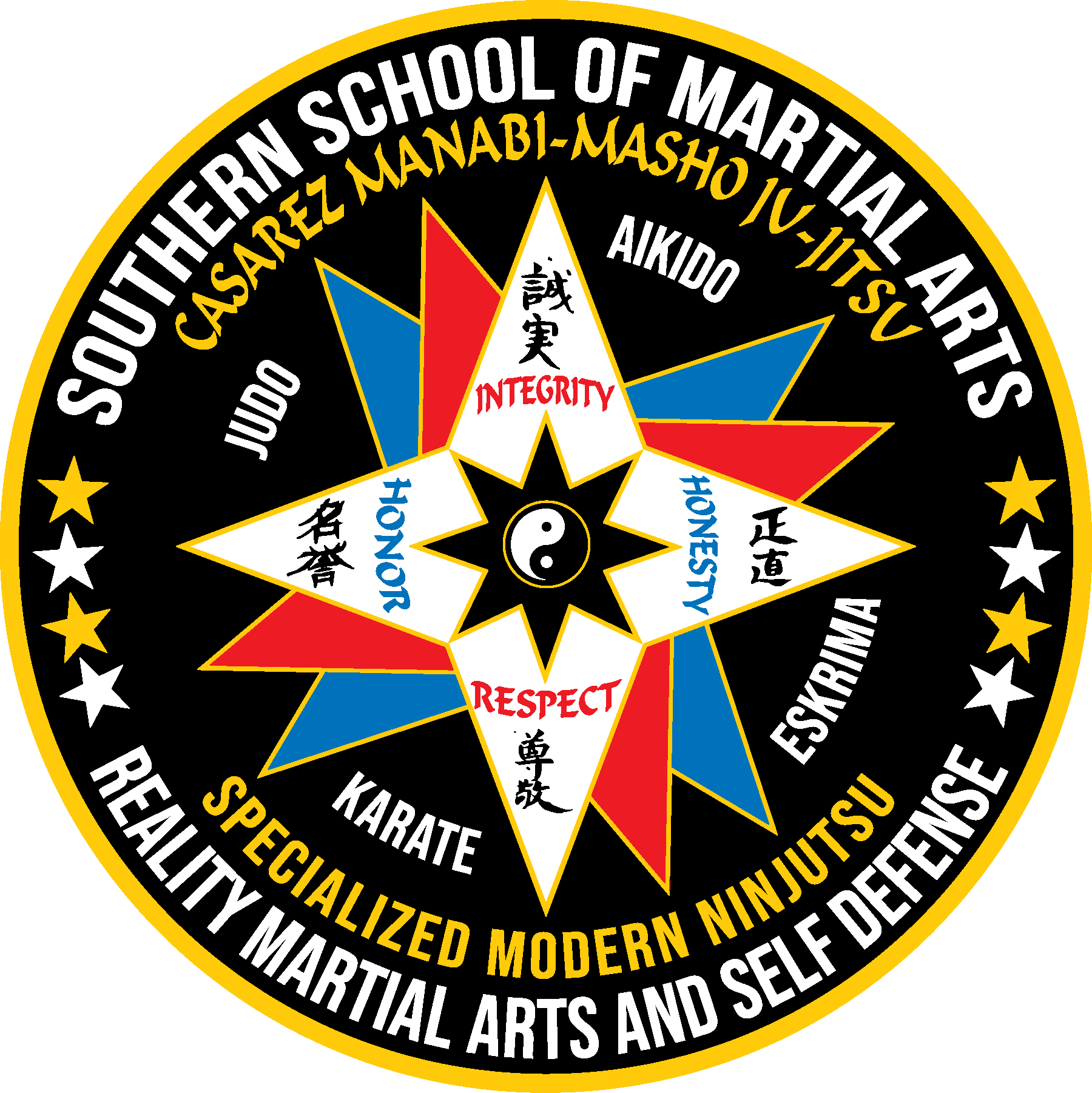
Traditional Bujinkan Ninpo/Budo Taijutsu class Thursdays 7:00pm to 8:00pm.
We are an IBDA dojo. Shidoshi Murdock has trained with Doshi Richard Van Donk for 30 years. Kyu Ranking can be from Doshi Van Donk or can be from the Homu Dojo in Japan. The student must pay extra for a Doshi Van Donk rank, or a Japanese rank when they are available. This is in additon to the Dojo's test price.
Rivers Edge Bujinkan Dojo Official Homepage
Bujinkan Budo Taijutsu, (Ninjutsu)

Shidoshi Mark Murdock
Shidoshi Murdock is a 5th Dan in Budo Taijutsu

Shidoshi Murdock's Godan certification
Shidoshi Murdock is officially Japan certified as a 5th Dan Bujinkan Shidoshi. Shidoshi Murdock has over 25 years in Bujinkan Budo Taijutsu (Ninjutsu).
We are now accepting new students.
We teach authentic Bujinkan Budo and Ninpo Taijutsu. This is the authentic Japanese martial art of Ninjutsu.
Rivers Edge Bujinkan Dojo is in the same building as the Southern School of Martial Arts. We teach this art at different times on the same nights as the Ju-Jitsu class.
This is a great martial art for self defense, self protection and for mental refinement, life fulfillment and goal setting. This martial art will help you achieve a great sense of awareness, focus, and personal wellbeing.
In the Budo Taijutsu (Ninjutsu) style, there’s striking, throwing techniques, grappling, joint locks with throws and takedowns, ground techniques, weapon techniques and disarms, exotic weapons not normally seen in other martial art styles and the use of stealth and survival training, and besides the physical aspects of the art are the mental refinement aspects that are taught. Budo and Ninpo Taijutsu (Ninjutsu) encompasses the Body, the Mind and the Spirit.
We’re currently accepting students. Please call 919-753-7964 for more information or to enroll. We have a free week trial in the Budo Taijutsu class.
These are the schools (Ryu) that make up the Bujinkan. This is a historic time for the Bujinkan with the transition of the art. Hatsumi Sensei is has retired and has passed the art to his Japanese DaiShihan (inheritors).
There are nine main martial traditions that comprise the Bujinkan Dojo training.
Togakure Ryu
Was founded by Diasuke Nishina who was raised as a vassal of Kiso Yoshinaka in the early 12th century. When Yoshinaka’s army was defeated in battle, Diasuke escaped to Iga. There he learned various martial skills such as kosshijutsu and kenjutsu from Kagakure Doshi. It was initially called Togakure Ryu Happo Biken but has been called by various names since that time. Togakure Ryu is known for its use of tekko, senban nage and shinodake (4-foot breathing tube). Tukumi Takumi Tsutsui Daishihan was promoted to 35th Soke of Togakure Ryu Ninjutsu December 2019.
Gyokko Ryu
It is believed that a Chinese person named Ikai introduced this art to Japan in the 8th century. According to Hatsumi Sensei, that person could also be somebody (kai) from a foreign (i) country. It is assumed that this kosshijutsu was based on Chinese martial arts. Although kosshijutsu means “to knock down an enemy with one finger”, it can also signify the “backbone” [spine] of the martial arts. Ishizuka Daishihan was promoted to 29th Soke of Gyokko Ryu Koshijutsu October 2019.
Kukishinden Ryu
The founder of this tradition was Yakushimaru Kurando Takazane, a palace guard of Emperor Godaigo in the 1330s. He was awarded the family name of Kuki (nine demons) for his spirited fighting and rescue of the Emperor. In addition to bo, yari, shuriken and unarmed fighting methods, this tradition is well known for its bojutsu and kenjutsu. Due in part to the Kuki family’s activities as suigun (navy) they adapted a low fighting posture that permitted better balance on turbulent waters. This tradition is related to Kukishin Ryu, which is well known for its bojutsu.
Shinden Fudo Ryu
This ryu was founded by Izumo Kanja Yoshiteru. A characteristic of this ryu is its recognition of shizen (“natural”) as the only necessary posture of defense. However, in reality, a person imagines a posture of defense in his mind and places himself on guard. This tradition has two sections of fighting (dakentaijutsu & jutaijutsu) as well as the philosophy of not drawing a sword unless absolutely necessary. Nagato Daishihan was promoted to 27th Soke of Shinden Fudo Ryu Dakentaijutsu November 2019.
Koto Ryu
This art was founded in the middle of the 16th century by Toda Sankyo Ishinsai, who had learned Gyokko Ryu from Gyokkan, a Buddhist monk. Koppojutsu originally came from ancient China and was also called Goho, which was characterized by its use of hidden weapons. The first kanji of koppo (kotsu) means bone, but can have the deeper meaning of “knack”. Noguchi Daishihan was promoted to 19th Soke of Koto Ryu Koppojutsu, December 2019.
Gikan Ryu
Founded by Unryu Hangan Gikanbo, Daimyo of Kawachi Province. He developed this art from his lessons in kosshijutsu. The lessons of this tradition are almost totally unknown to the public and many of its secret techniques were handed down from soke to soke only.
Takagi Yoshin Ryu
Traces its lineage back to the 16th century scroll Rinpo Hiden, which was studied by Ito Ki-i no Kami. This tradition was founded by Takagi Oriemon Shigenobu. This art developed through the years and has strong links to Takeuchi Ryu, Kukishin Ryu and Hontai Yoshin Ryu. This tradition teaches to always remain calm and flexible like the willow.
Gyokushin Ryu
This art is a branch of kosshijutsu and was founded by Sasaki Goemon Teruyoshi. Characteristics of this tradition include its unique usage of nawa nage (rope throwing) and espionage techniques. The secrets of this tradition have only been hinted about by the current grandmaster. Kan Daishihan was promoted to 22nd Soke of Gyokushin Ryu Ninpo in December 2019.
Kumogakure Ryu
This martial art was founded by Heinaizaemon Ienaga Iga (Kumogakure Hoshi) who was also believed to be the originator of Iga Ryu Ninjutsu. The special skills of this tradition include its use of the kamayari (sickle spear) and kote uchi (forearm striking) techniques. Much of the training in this tradition is said to be likened to the taijutsu and philosophies of escape and evasion techniques in Togakure Ryu. Furuta Daishihan was promoted to 15th Soke of Kumogakure Ryu Ninpo December 2019.
Other training:
As well as the above mentioned Bujinkan traditions, our dojo training also encompasses several other martial traditions as well. For instance, our kusari fundo training comes from Masaaki Ryu, while our daisho sabaki training comes from Takagi Yoshin Ryu, and our black belt level Shinken Gata training is derived from the philosophies and strategies of samurai hundreds of years ago. Some weapon training is derived from Kukishin Ryu and other ryu.
Truth about Shinobi (Ninja)
What image comes to mind when you hear the word “ninja”? Perhaps you imagine figures “dressed in black, sneaking into enemy castles,” “throwing shuriken,” “walking on water and vanishing in a puff of smoke after weaving mysterious hand signs,” or the legendary “ninjas of Iga and Kōka.” These images are familiar, shaped by kabuki theater, woodblock prints, novels, and modern media. Yet, while some aspects reflect reality, many are exaggerations or outright misconceptions (Turnbull, Ninja: Unmasking the Myth, 2017).
Historically, the existence of ninja, referred to more commonly in older texts as shinobi, can be traced in written records as early as the Nanboku-chō period (1336–1392). At this time, they served local warlords as specialists in infiltration, espionage, arson, and night raids (Seiryōin, Nihon no Shinobi, 2004). Their ultimate mission, however, was not simply sabotage but survival. To live, to return, and to report intelligence to one’s lord was the highest duty of the shinobi.
Far from the romanticized assassins of popular culture, the ninja were primarily intelligence operatives. In the Sengoku period (1467–1603), an era when even the smallest fragment of information could tip the balance between victory and defeat, the role of the shinobi became invaluable. For this reason, they avoided unnecessary combat, as death meant failure. Their training emphasized cunning, adaptation, and discretion over open displays of martial prowess (Friday, Samurai, Warfare and the State in Early Medieval Japan, 2004).
The arts of the shinobi, collectively called ninjutsu, can be understood in two broad categories:
• Yō-ninjutsu (陽忍術): overt intelligence gathering, which relied on communication, persuasion, and blending into society to extract information.
• In-ninjutsu (陰忍術): covert intelligence gathering, which involved stealth, disguise, infiltration, and clandestine operations.
Although the popular imagination often focuses on in-ninjutsu, the shadowy night raids and scaling of castle walls, historical studies show that yō-ninjutsu was considered the primary and most reliable approach. Covert methods were auxiliary, reserved only for situations when open intelligence gathering was impossible (Sasaki, Ninjutsu no Rekishi, 1968).
A telling example comes from the Kōka Shinobi no Den Miraiki, written by Chikamatsu Shigenori, a strategist of the Owari domain (present-day western Aichi Prefecture). He observes that while disguises and wall-scaling were indeed part of ninjutsu, they were “trivial and impractical.” He warned that if one were to rely solely on such techniques, no great success as a shinobi could be expected (Chikamatsu, Miraiki, 1655). His words overturn the popular, romanticized image of the ninja and point us toward their true essence as practical and highly adaptable intelligence specialists.
This lineage of survival and intelligence work did not vanish with the end of the Sengoku wars. In the late Edo period, Toda Hisajirō, later known by his teaching name, Toda Shinryūken Masamitsu, played a crucial role in preserving and transmitting shinobi-related martial traditions. Toda was a swordsman and falconer with ties to the Tokugawa shogunate, and he taught martial arts at the Kobushō, the shogunate’s military academy (Hatsumi, Essence of Ninjutsu, 1988). His position placed him within networks of intelligence and security services that retained knowledge inherited from Iga and Kōka shinobi families.
According to the Bugei Ryūha Daijiten (Watatani & Yamada, 1978), Toda was a key figure in the transmission of the Togakure-ryū Ninpō Taijutsu, one of the few ninjutsu lineages that survived into the modern era. This tradition was handed down through Takamatsu Toshitsugu (1889–1972), who in turn taught Masaaki Hatsumi, founder of the Bujinkan Dōjō.
The Bujinkan preserves nine classical martial schools (ryūha), of which Togakure-ryū is the best known for its direct shinobi heritage. In his writings, Hatsumi emphasizes that ninjutsu is not a collection of battlefield tricks but a holistic system of survival, adaptability, and strategy. The heart of the art lies not in theatrical combat but in the will to endure, to protect one’s community, and to harmonize with changing circumstances (Ninjutsu: History and Tradition, Hatsumi, 1981).
So, while the word “ninja” may conjure images of black-clad warriors and mystical powers, the historical and living legacy of the shinobi tells a different story. They were highly skilled intelligence agents, survivalists, and martial artists whose primary goal was not theatrical displays or assassination but endurance, adaptability, and service to their communities.
Through figures like Toda Hisajirō and the traditions safeguarded in the Bujinkan Dōjō, we can glimpse the true essence of ninjutsu, a discipline rooted not in fantasy, but in the timeless art of survival.
Sean Askew
導冬・龍隠 Dōtō・Ryū-In
Bujinkan Daishihan – Koto Ryu Menkyo Kaiden
9/30/2025
Sources
• Chikamatsu Shigenori, Kōka Shinobi no Den Miraiki (1655).
• Friday, Karl. Samurai, Warfare and the State in Early Medieval Japan. Routledge, 2004.
• Hatsumi, Masaaki. Ninjutsu: History and Tradition. 1981.
• Hatsumi, Masaaki. Essence of Ninjutsu. 1988.
• Sasaki, Ginichi. Ninjutsu no Rekishi. Tokyo: Jinbutsu Ōraisha, 1968.
• Seiryōin, Ryūsui. Nihon no Shinobi. Tokyo: Shakai Shisōsha, 2004.
• Turnbull, Stephen. Ninja: Unmasking the Myth. Frontline, 2017.
• Watatani, Kiyoshi & Yamada, Tadashi. Bugei Ryūha Daijiten. 1978.


